Last Updated on April 4, 2024
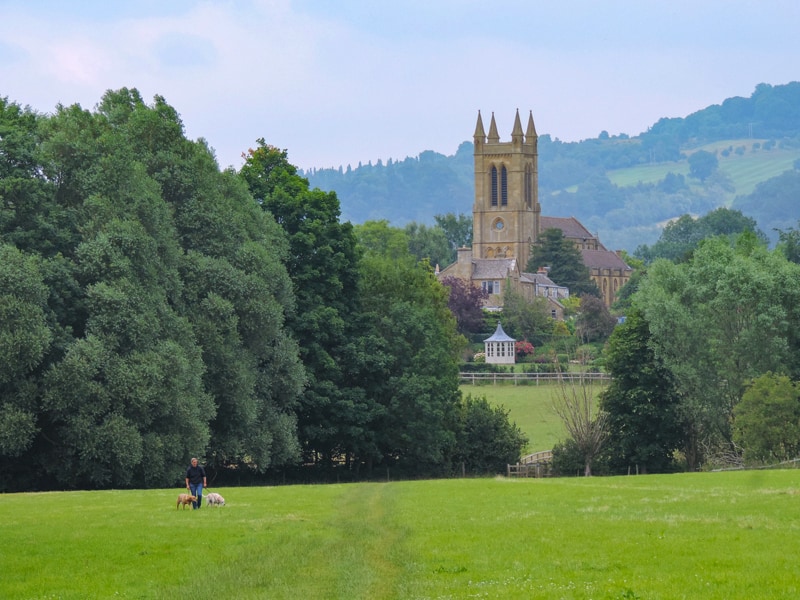
Estimated reading time: 16 minutes
By Jim Ferri
From a traveler’s perspective, England’s Cotswolds doesn’t sound very inviting at all.
They’re just 50 miles of limestone hills stretching northeast from Bath in south-central England.
They cover about 800 square miles, encompassing part of five counties – Gloucestershire, Oxfordshire, Warwickshire, Wiltshire, and Worcestershire.
In fact, centuries ago, farmers found the area wasn’t even suitable for farming.
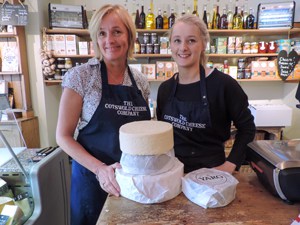
But what it was found to be suitable for was raising sheep. As a result, the Cotswolds soon became the center of English wool production. Moreover, Cotswold wool became renowned as the finest in Europe.
With that came great wealth for the wool merchants and, soon after that, the building of beautiful towns and villages. Over the centuries, these tranquil cottage-filled villages and towns expanded while maintaining their iconic and pastoral beauty.
Today there seems to be no end to the many charming villages hamlets scattered about the countryside. That’s also true for the dry-stone walls you see running across the hills, keeping all those sheep close to home. It’s one of the prettiest areas in Britain and has been designated as an Area of Outstanding Natural Beauty.
Moreover, it’s only about a two-hour drive from central London, 1 hour and 30 minutes from Heathrow. Since it was so close, I decided to spend two nights and three days visiting this much-talked-about area.
A note: although you can take a bus tour of the Cotswolds, see it by car if you can. A car gives you the ability to poke into the region’s many nooks and crannies.
You’ll find rentals at London’s Heathrow as well as in Oxford, Bath, and other nearby cities.
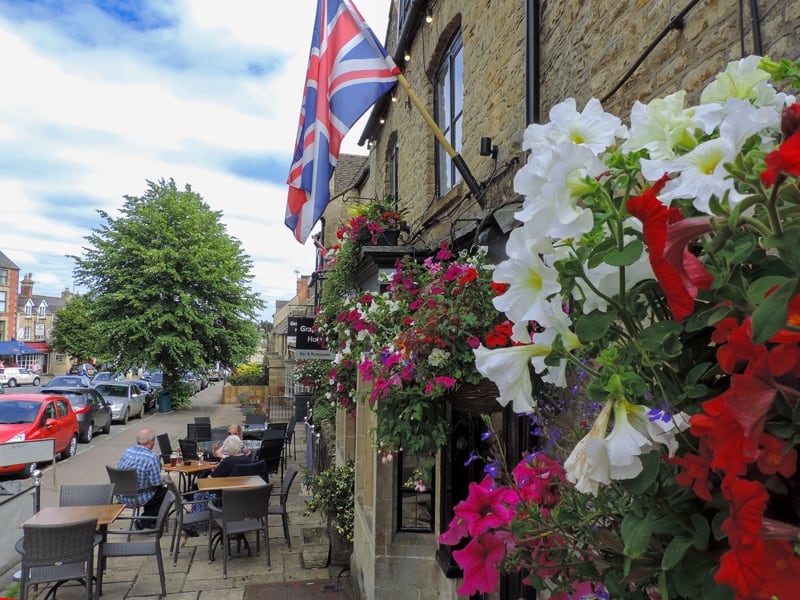
An Introduction to the Cotswolds
To non-British travelers, many towns in the Cotswolds have odd-sounding names. Stow-on-the-Wold, Chipping Campden, Upper Slaughter, and Bourton-on-the-Water, for starters.
That’s because they are derived from Old English. “Cotswold,” for example, is a combination of the word “cots,” indicating sheep enclosures, and “wolds,” meaning gentle hills. “Chipping” is an Old English word for market.
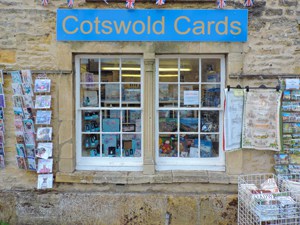
The area is a favorite for busloads of tourists who continually roll through the region. However, if you come by car, you’ll find it easy to navigate since its famous villages are often near one another.
With the wealth the wool merchants of the Cotswolds accumulated, they built beautiful homes. They also constructed beautiful churches, called “wool churches,” in reference to the source of their funding. The wool churches in Chipping Campden, Cirencester, and Northleach are beautiful and the most renowned. Each of them is worth a visit.
Throughout the Cotswolds, there are also many honey-colored homes or cottages, their color coming from the type of limestone used. Occasionally, you’ll also see a thatched cottage in addition to the grand mansions built by the merchants centuries ago.
Cotswold Shopping
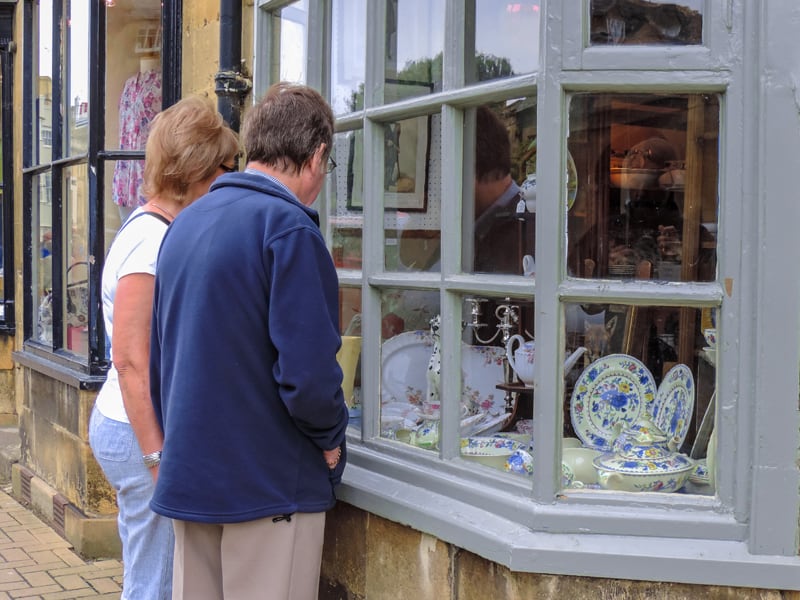
Since medieval times the Cotswolds has been famous for its markets, and several continue to operate today. For example, in Cirencester, the Charter Market in Market Place is open Monday and Friday. In addition, you’ll find the Craft Market in Corn Hall open on the 2nd and 4th Saturday of the month.
The Moreton in Marsh Outdoor Market is open every Tuesday and advertises itself as the largest street market in the Cotswolds. It sells everything from leather goods and books to fish, produce, and pet products.
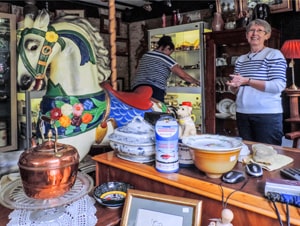
If you’re a traveler who enjoys antiques, in the Cotswolds you will find numerous antique shops, but don’t expect to discover bargain items. The main towns for antique shops are Chipping Camden, Moreton-in-Marsh, Broadway, and Stow-on-the-Wold. There are also shops and galleries selling handicrafts, including pottery, jewelry, hand-blown glass, ceramics, etc.
More than a century ago, the Arts and Crafts movement thrived in the area, and you’ll still find many arts and crafts being sold throughout the region.
You’ll also find antiques and handicrafts sold in numerous stores, workshops, and galleries throughout the Cotswolds.
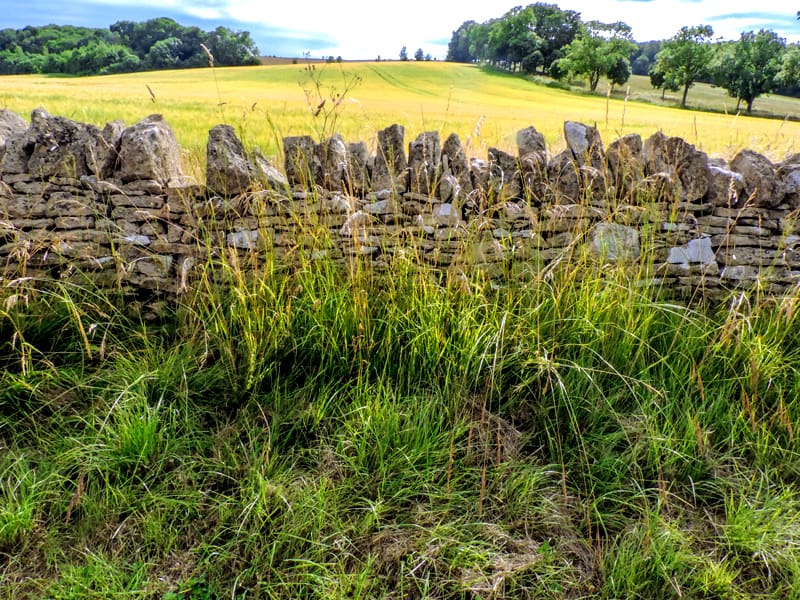
When To Go
Spring and autumn, when the crowds are fewer, are beautiful seasons to visit the Cotswolds. However, as you might suspect, Cotswolds villages are filled with British and foreign travelers during the summer, especially on weekends. Therefore, if you must visit during the summer months, you’ll find it much more comfortable to time your visit during the week.
If you’re driving in the Cotswolds, you’ll find the roads well maintained, although they are narrow in places. In addition, be aware that you may encounter a farmer’s tractor or someone on horseback around any turn.
Whether you arrive in a rental car or by train, here are six places in the Cotswolds that rate high on the “Wow” factor. They’re also straightforward to reach and are pretty near to one another.
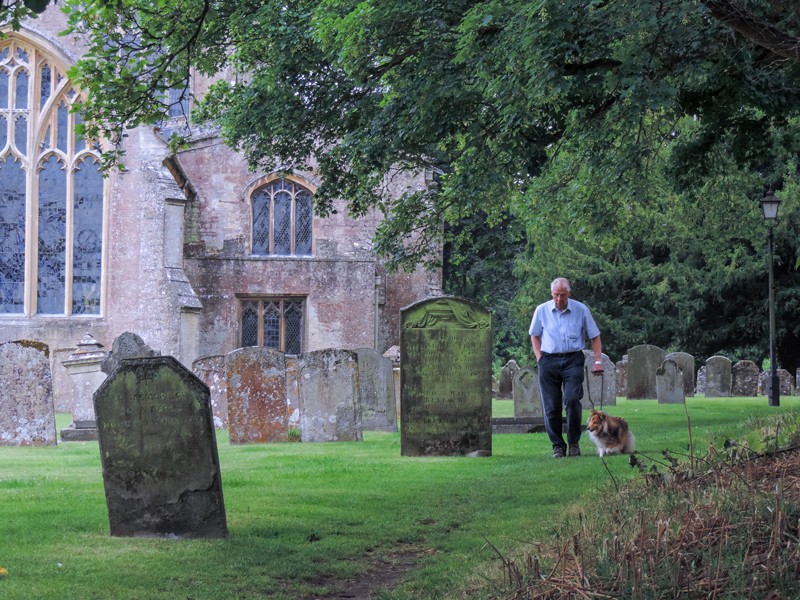
Northleach
I started my Cotswolds tour from Bath and drove up to Northleach, an unassuming little Cotswold village. The town center surrounds a semicircle of limestone buildings housing cafés, shops, and the village post office.
After looking into the tiny post office, I took the path next to it up to the church of St. Peter and St. Paul. The trail cut across a graveyard where centuries-old tombstones jutted up from the neatly clipped bright green grass. The church itself is one of the historic “wool churches” and is a beautiful place to visit. The churches were financed by wealthy wool merchants who built these Cotswold towns in medieval times.
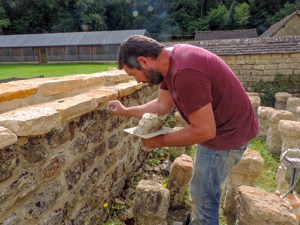
When I returned to the village center, I walked about 50 yards up the street to Keith Harding’s Mechanical Music Museum. It’s a tiny museum that’s a wonderful place to listen to an old player piano and other musical instruments. Unfortunately, it’s now closed due to the death of its owner but, hopefully, it will open again.
After leaving Northleach, I set off for the Chedworth Roman Villa, an easy 15-minute drive. This important Roman-British villa was discovered nestled in the woods in 1864, and archeologists are still working on the site.
Inhabited from the 2nd – 4th centuries AD, it has a pool, under-the-floor heating, and beautiful mosaics. I found it fascinating but couldn’t help wonder why it took 1500 years to be discovered.
If You Go:
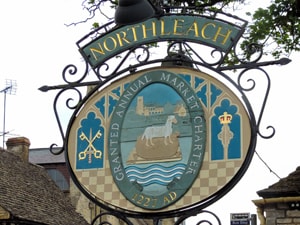
Keith Harding’s World of Mechanical Music
High Street
Northleach, Gloucestershire GL54 3ET
Tel: 01451 860181
Admission: £8
Chedworth Roman Villa
Yanworth, near Cheltenham,
Gloucestershire, GL54 3LJ
[email protected]
Tel: 01242890256
Admission: Adult £11, Child £5.50, Family £27.50
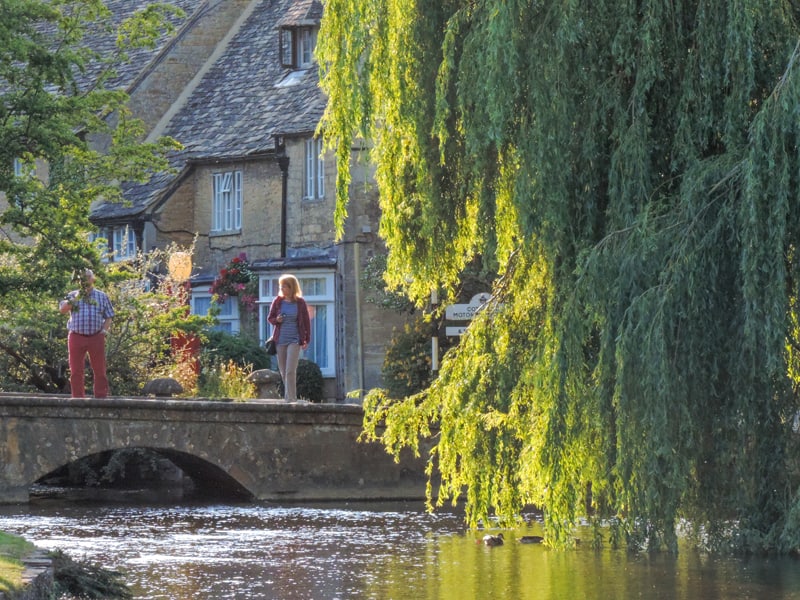
Bourton-on-the-Water, the Quintessential Cotswold Village
If you head northward on Route A429, you’ll come to Bourton-on-the-Water. It’s only a 10-minute drive from Northleach.
Bourton-on-the-Water, one of the most popular tourist stops, is a beautiful village in the Cotswold countryside. Although the Cotswolds can get crowded during the height of the summer season, the town is spread out enough that it doesn’t feel overcrowded at all.
I loved Bourton-on-the-Water, the “water” referring to the River Windrush, which bisects the village. It’s a relaxing town with a lovely village green that has shops and restaurants around its periphery. Plan for lunch or dinner here.
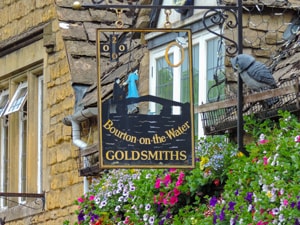
It’s the quintessential Cotswold village, a beautiful town of limestone buildings with moss-covered slate roofs and flowers in bloom everywhere. The village green, its grass sometimes speckled with people picnicking, sits along the shallow River Windrush lined with little stores and cottages, restaurants, and cafés.
One evening I had dinner at the Rose Tree, a little restaurant on the Windrush. The dinner was delicious, and the staff was accommodating. They even found me an inside table on a cool July evening when they were fully booked.
In Bourton, you’ll also find the Cotswold Motoring Museum and Toy Collection, the 40-train Model Railway Exhibition, and the Model Village, a scale model of the town. More interesting to some, I would think, is the interesting Cotswold Perfumery, a shop, factory, and museum that hand-crafts perfumes. Take a tour.
I overnighted in Bourton-on-the-Water at the Mousetrap Inn. It’s an 18th-century family-run inn that was comfortable, although in need of an update when I visited. Its restaurant/pub, however, receives high ratings for its upscale menu.
If You Go:
Rose Tree Restaurant
Riverside, Victoria St,
Bourton-on-the-Water, Cheltenham GL54 2BX
[email protected]
Tel: +44 1451 820635
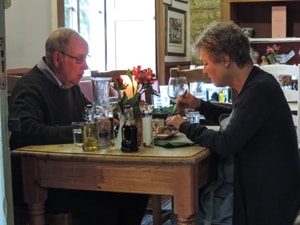
Cotswold Motoring Museum and Toy Collection
The Old Mill, Sherborne St.
Bourton-on-the-Water, Cheltenham GL54 2BY
Tel: +44 1451 821255
Admission: Adult £6.75, Child (16 and Under) £4.80, Child (under 8) Free
Model Railway Exhibition
Box Bush, High St.
Bourton-on-the-Water, Cheltenham GL54 2AN
Tel: +44 1451 820686
Admission: Adult £2.75, Child £2.25, 2 Adults and 2 children £8.50
Cotswold Perfumery
Victoria St.
Bourton-on-the-Water, Cheltenham GL54 2BU
[email protected]
Tel: +44 1451 820698
Mousetrap Inn
Lansdowne
Bourton-on-the-Water, Cheltenham GL54 2AR
[email protected]
Tel: +44 1451 820579
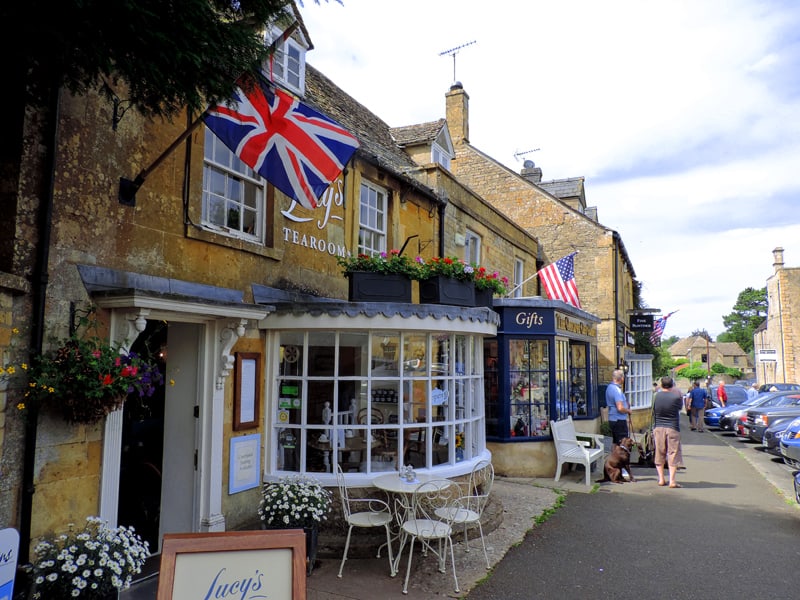
Stow-on-the-Wold
Less than another 10-minute drive further north on A429, is Stow-on-the-Wold. Situated on a hilltop, it sits at the junction of seven old roads. One of them is the ancient Fosse Way, a major Roman road that traversed Britain.
The town was founded initially by Norman lords to take advantage of the trade traffic passing through the junction. It later became one of the region’s preeminent market towns.
Stow doesn’t have a village green as does Bourton-on-the-Water. It instead surrounds a large parking area, probably a relic from its market-town days. But it does have a small village green tucked away in the corner of the parking area that contains the village’s old stocks. Even though somewhat worn away with age, it still offers plenty of fodder for tourist cameras.
In Stow, you find plenty of shops, especially charming antique shops, as you get further from the center.
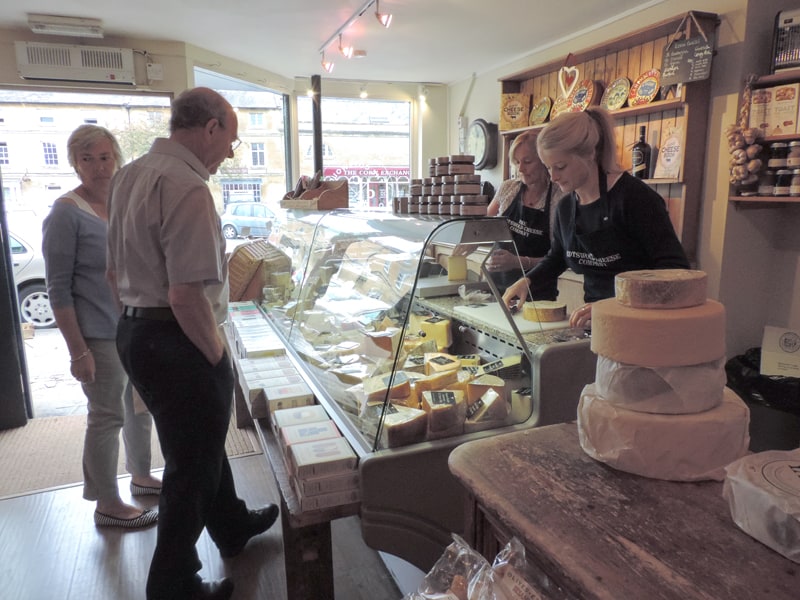
Moreton-in-Marsh
Moreton-in-Marsh is a town famous for its Tuesday market. Also founded on the old Roman road, it’s been a traveler’s town for more than 1700 years.
When I arrived, I thought it looked rather uninviting at first. Still, after I had started wandering around, I found it quite interesting. I enjoyed many of the shops throughout the village.
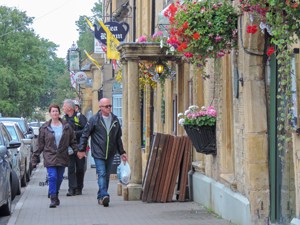
If you love cheese, you’ll be in heaven in the Cotswolds since its cheeses are renowned. In Moreton-in-Marsh, I (GREATLY) enjoyed the Cotswold Cheese Company, which offers over 120 different artisan and farmhouse cheeses, including the aromatic “Stinking Bishop.” Moreton-in-Marsh is its flagship store (at 5 High Street, the main thoroughfare).
The two women inside offered not only a good selection of local cheeses but also a large variety of olives, pasta, bread, and other comestibles. Had my timing been better, it would have been an excellent place to put together a picnic snack. It also has stores in Stow-on-the-Wold and Burford, another Cotswold town.
Outside of town, there’s the Batsford Arboretum, a collection of exotic trees and shrubs (it’s also a garden center), and the highly-rated Cotswold Falconry Centre.
The drive through the countryside across the hills and valleys outside of Moreton was quite relaxing. That was all due to the lack of oncoming traffic on the one-lane road. The only traffic I did encounter was a young woman riding a beautiful gray mare. The two of them fit exceptionally well into the pastoral tableaux all around me.
If You Go:
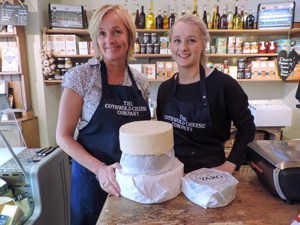
Cotswold Cheese Company
5 High St.
Moreton-in-Marsh GL56 0AH
[email protected]
Tel: +44 1608 652862
Batsford Arboretum
Batsford, Moreton-in-Marsh GL56 9AT
[email protected]
Tel: +44 1386 701441
Cotswold Falconry Centre
Batsford, Moreton-in-Marsh GL56 9AT
[email protected]
Tel: +44 1386 701043
Admission: Adult (16 and older) £12, Child (4-16) £6
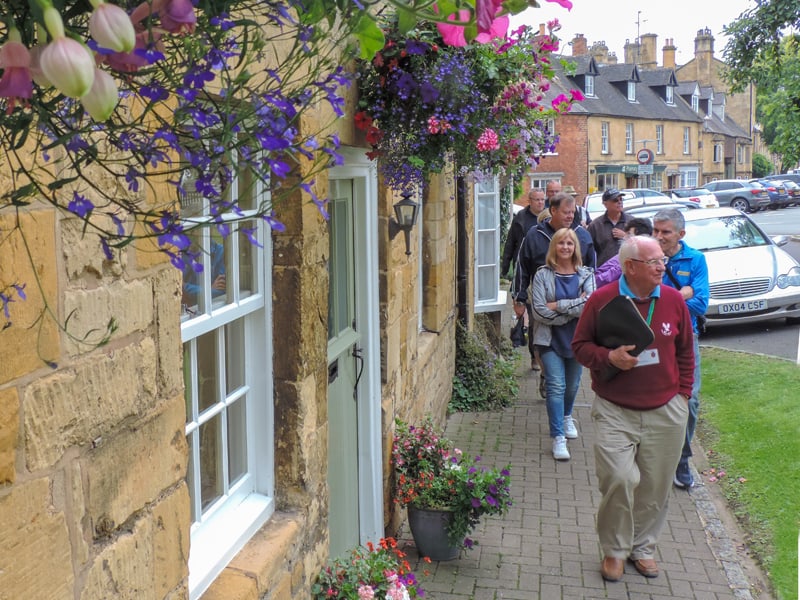
Chipping Camden and the Cotswold Way
Chipping Campden, my next stop, and at the northern end of the famous Cotswold Way, was less than 20 minutes from Moreton-in-Marsh.
The Cotswold Way is a 100-mile walking trail that winds its way down through the Cotswolds to Bath in the south. Depending on your perspective, it begins or ends in the parking lot adjacent to the Old Market Hall. The Hall was built in 1627 to provide shelter to merchants and farmers selling goods like cheese, butter, and poultry. But, despite what many visitors to the Cotswolds might assume, it wasn’t constructed to benefit the wool merchants.
Chipping Campden is a beautiful village and an important medieval wool town. Although wool merchants once came to its Woolstapler Hall, today it is known as an arts and crafts center, ever since the movement took root there at the beginning of the 20th century. It also continues today with the Court Barn Museum, which highlights crafts and design in the north Cotswolds.
You’ll find a lot of history in Chipping Campden, including 16th-century St. James’s Church, considered another of the Cotswolds finest “wool churches.” I was amazed at how old many of the town’s buildings seemed to be, with their roofs sagging under the weight of the old, heavy slate.
You may also be interested in English Garden Tours / The Top 10 Places in England / Day Trip: London to Bath
Just Wandering About
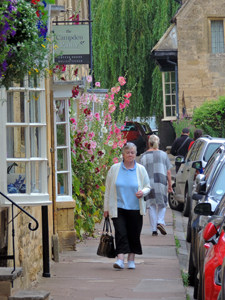
I immensely enjoyed its High Street, renown as one of the most attractive High Streets in all of Britain. Everything was picture-perfect, with flowers everywhere, especially the colorful cascades of petunias from pots on the honey-colored limestone walls. All was prim and proper, every bush and lawn impeccably manicured.
I wandered about, passing a group taking a walking tour with a local guide, all hanging on his every word. Finally, after a few hours or so, I decided to look at the town from afar, something I didn’t do on the way in.
I got in my car and just followed my instincts, exiting the village and turning down a narrow road. I was heading towards woodlands, but I stopped when I saw a woman walking her two dogs across a meadow after just a few minutes. Behind her was Chipping Campden with the spires of St. Michael and All Angels Church soaring upward in the distance. It was picture-perfect Cotswolds.
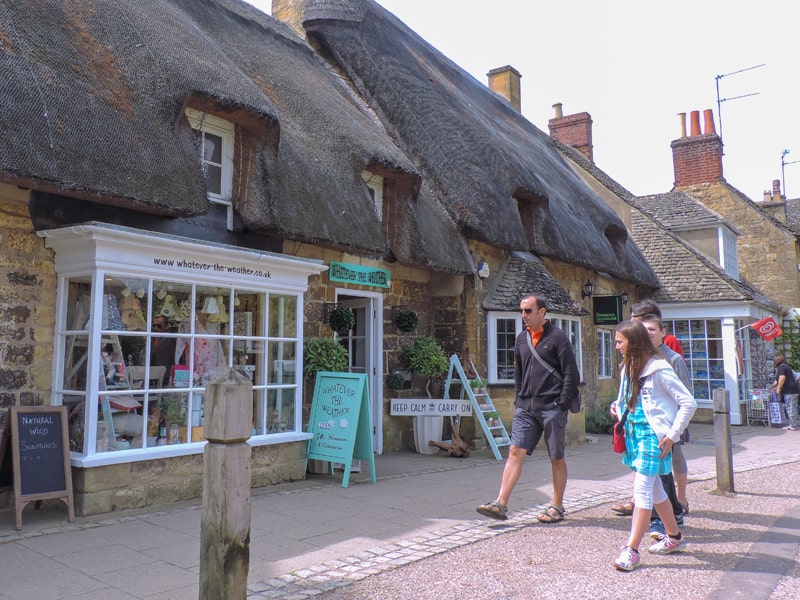
Broadway in the Northern Cotswolds
At the northern end of the Cotswolds in Worcestershire, Broadway is another beautiful Cotswold town. Notables who have stayed in the town and are said to have drawn inspiration from it. They include Oscar Wilde, Henry James, John Singer-Sargent, Claude Monet, and Edwin Abbey. It’s a pleasant place to wander about for a few hours, if not much longer.
It has a beautiful “broad way,” aka High Street, one of the longest in England. The street is lined with chestnut trees and honey-colored limestone houses, shops, tearooms, and restaurants. Its architecture is a mix of Georgian, Tudor, and Stuart.
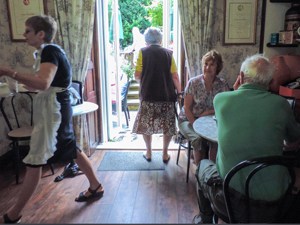
Walking up High Street, I stopped here and there, poking my head in everywhere. Before long, I reached the town’s small War Memorial. Anchoring an inviting little lane to the center of town, I turned down it to see what was there.
I immediately came to Tisanes Tea Rooms in a 17th-century-Cotswold stone building. Since it looked pretty inviting, I went in for a coffee and a snack. Though the shop with its small tables looked comfortable, I instead headed for the small garden outback. For the next half-hour, I relaxed next to a lavender garden, plotting my touring strategy for the remainder of the day.
On the way back to my car, I soon passed Haynes Fine Art of Broadway. A small sign in front of the building read, “Named as one of the top 5 privately owned galleries in the world.”
Later, while driving across the region’s beautiful landscape, I remember thinking that the Cotswolds were undoubtedly one of the top 5 places to visit in England. Spend a few days there, and you’ll understand why.
If You Go:
Tisanes Tea Rooms
Cotswold House, 21 The Green
Broadway WR12 7AA
[email protected]
Tel: +44 1386 853296

All of your stops sound so inviting! Thanks for a great look at the Cotswolds. I love your fun story. It is so thorough and interesting.
Several years ago, I stayed at the Lygon Arms Inn in Broadway. I am sorry you did not mention it in your article. It’s an historic an historic inn and very comfortable. We went horseback riding on a chilly beautiful day.
Hi Carole, I’m sorry also but it’s exceptionally difficult to name several hotels in an article since you never know which are the best. So I usually only mention the one where I’ve stayed and can make a comment on it based upon my experience.